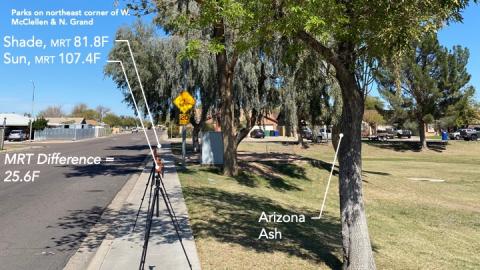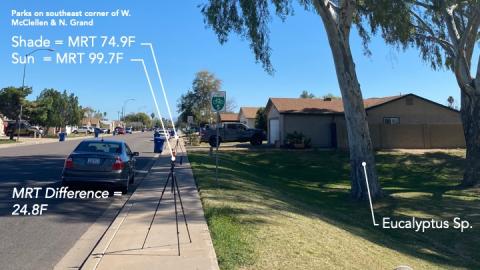West Mesa River Community Heat Action Project
Guest post from Cori Dolan with the Arizona Department of Forestry and Fire Management in coordination with the Western Urban and Community Forestry Network's #HealthyTreesHealthyLives social media campaign.

One of the major issues Urban and Community Forestry is attempting to combat with increased canopy cover, especially in the arid Southwest, is the Urban Heat Island. In Greater Phoenix, rapid and extensive urbanization has led to an Urban Heat Index (UHI) in the metropolitan area that has increased steadily at approximately 0.9°F (0.5°C) per decade. A time-trend analysis of Phoenix Sky Harbor air temperatures showed nighttime temperature differences between rural and urban areas of up to 11°F (6°C) in the summer. Recent research at Arizona State University indicated that increasing tree canopy cover to 25% leads to an additional temperature reduction of 4.3°F, which is a total cooling benefit of 7.9°F as compared to a bare neighborhood. While research indicates a goal of 25% canopy cover through both natural and engineered shade, American Forests recommends a tree canopy of 15% for desert cities as a target. Using methodology developed and deployed in the Nature’s Cooling Systems Projects for Heat Action Planning in Greater Phoenix, increasing the minimum tree coverage in all census block groups to 10% by 2040 would be a significant achievement.

With funding provided by the AZ Department of Forestry and Fire Management, multiple stakeholders launched this participatory Heat Action Planning process to identify both mitigation and adaptation strategies to reduce heat directly and improve the ability of residents to deal with heat. Partners include West Mesa Community Development Corporation, The Nature Conservancy, the City of Mesa, Arizona Sustainability Alliance, and Arizona State University’s Urban Resilience to Extremes Sustainability Research Network, Urban Climate Research Center, and University City Exchange. These partners include community-based organizations with existing relationships in the West Mesa river community neighborhoods selected for Heat Action Planning who are dedicated to river revitalization through collective action and understand the importance of our urban waterways and the delicate balance between our built and natural environments.

The iterative planning and engagement method used by the project team will strengthen relationships within and between neighborhoods, community-based organizations, decision-makers, and the core team, and combines storytelling wisdom and scientific evidence to understand current and future challenges residents face during extreme heat events. As a result of the proposed workshop format within the West Mesa river community, neighborhood residents will be asked for ideas that they would like to see implemented to increase their thermal comfort and safety during extreme heat days. As demonstrated by prior Mesa residents, the amount and quality of shade in their community is not adequate. They are particularly concerned about the elderly and children walking to and from schools, parks, and other community facilities. Compounding this issue is the urban fabric which favors traffic movements and subjecting pedestrians to extensive intersection wait times and limited shade. The community’s insight provides a basis to pursue an urban canopy and vegetation to improve air quality, reduce temperatures, reduce and filter stormwater runoff, and enhance quality of life.